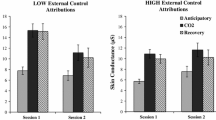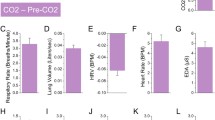Abstract
This study aimed to further understanding of cognitive behavioral models of panic disorder by determining whether individuals with panic disorder differ from normal controls in the accuracy with which they are able to detect changes in heart rate. Twenty-six subjects with panic disorder and 14 normal controls continuously estimated heart rate changes under two conditions which were designed to increase autonomic arousal and also under a relaxation control condition. Panic-disordered subjects had better cardiac acuity than the controls in the arousal condition, which engendered less feelings of safety and control, but there were no differences between the groups in the other two conditions. Although the panic-disordered subjects scored significantly higher than the controls on a measure of anxiety sensitivity, this variable was not related to cardiac acuity for either group. These results were interpreted as supporting a psychological model of panic disorder which posits increased internal attentional focus as being most likely to occur in situations associated with a perceived pattern of arousal most resembling that occurring during a typical panic attack.
Similar content being viewed by others
References
American Psychiatric Association. (1987).Diagnostic and statistical manual for mental disorders (3rd ed., rev.). Washington, DC: Author.
Antony, M. M., Brown, T. A., Craske, M. G., Barlow, D. H., Mitchell, W. B., & Meadows, E. A. (1995). Accuracy of heart-rate estimation in panic disorder, social phobia and non-anxious controls.Journal of Anxiety Disorders, 9(5), 355–371.
Barlow, D. H. (1988). Anxiety and its disorders:The nature and treatment of anxiety and panic. New York: Guildford Press.
Barlow, D. H., & Craske, M. G. (1989).Mastery of your anxiety and panic. Albany, NY: Graywind.
Benson, H. (1975).The Passive relaxation response. New York: Morrow.
Butler, K. S., & Rapee, R. M. (1991). The influence of anxiety on accuracy of heart-rate estimations.Behavior Change, 8, 117–123.
Clark, D. M. (1986). A cognitive approach to panic.Behaviour Research and Therapy, 24, 461–470.
Clark, D. M. (1988). A cognitive model of panic attacks. In S. Rachman & J. D. Maser (Eds.),Panic: Psychological perspectives (pp. 71–89). Hillsdale, NJ: Erlbaum.
Clark, D. M., Salkovskis, P. M., Gelder, M., Koehler, K., Martin, M., Anastasiades, P., Hackman, A., Middleton, H., & Jeavons, A. (1988). Tests of a cognitive theory of panic. In I. Hand & H. U. Wittchen (Eds.),Treatments of panic and phobias: Modes of application and variables affecting outcome. Berlin: Springer-Verlag.
Craske, F. M., & Barlow, D. H. (1994). Panic disorders and agoraphobia. In D. H. Barlow (Ed.),Clinical handbook of psychological disorders (pp. 1–47). New York: Guildford Press.
Di Nardo, P. A., & Barlow, D. H. (1988).Anxiety Disorders Interview Schedule-Revised (ADIS-R). Albany, NY: Graywind.
Di Nardo, P. A., Moras, K., Barlow, D. H., Rapee, R. M., & Brown, T. (1993). Reliability of DSM-III-R anxiety disorder categories using the Anxiety Disorders Interview Schedule-Revised (ADIS-R).Archives of General Psychiatry, 50, 251–256.
Ehlers, A. (1989). Interaction of psychological and physiological factors in panic attacks. In P. Lovibond & P. Wilson (Eds.),Clinical and abnormal psychology (pp. 1–14). Amsterdam: Elsevier Science.
Ehlers, A., & Breuer, P. (1992). Increased cardiac awareness in panic disorder.Journal of Abnormal Psychology, 101, 371–382.
Ehlers, A., Margraf, J., & Roth, W. T. (1988). Selective information processing, interoception and panic attacks. In I. Hand & H. U. Wittchen (Eds.),Treatments of panic and phobias: Modes of application and variables affecting outcome. Berlin: Springer-Verlag.
Ehlers, A., Margraf, J., Roth, W. T., Taylor, C. B., & Birbaumer, N. (1988). Anxiety induced by false heart-rate feedback in patients with panic disorder.Behaviour Research and Therapy, 26, 1–11.
Hartl, L., Nutzinger, F. D., & Strian, F. (1990, June).The role of cardioception in anxiety disorders. Paper presented at the First International Congress on Behavioral Medicine, Uppsala, Sweden.
Harvey, J. M., Richards, J. C., Dziadosz, T., & Swindell, A. (1993). Misinterpretation of ambiguous stimuli in panic disorder.Cognitive Therapy and Research, 17, 235–248.
Hays, W. L. (1963).Statistics for Psychologists. New York: Holt, Rinehart & Winston.
Katkin, E. S. (1985). Blood, sweat, and tears: Individual differences in autonomic self-perception.Psychophysiology, 22, 125–138.
King, R., Margraf, J., Ehlers, A., & Maddock, R. (1986). Panic disorder: Overlap with symptoms of somatization disorder. In I. Hand & H. U. Wittchen (Eds.),Panic and phobias (pp. 72–77). Berlin: Springer-Verlag.
Margraf, J., Barlow, D. H., Clark, D. M. & Telch, M. J. (1993). Psychological treatment of panic: Work in progress on outcome, active ingredients, and follow-up.Behaviour Research and Therapy, 31, 1–8.
Margraf, J., & Ehlers, A. (1990). Biological models of panic disorder and agoraphobia: Theory and evidence. In G. D. Burrows, M. Roth, & R. Noyes, Jr. (Eds.),Handbook of anxiety: Vol 3. The neurobiology of anxiety. Amsterdam: Elsevier Science.
McNally, R. J. (1990). Psychological approaches to panic disorder: A review.Psychological Bulletin, 108, 403–419.
McNally, R. J., & Lorenz, M. (1987). Anxiety sensitivity in agoraphobics.Journal of Behavior Therapy and Experimental Psychiatry, 18, 3–11.
Pennebaker, J. W. (1982).The psychology of physical symptoms. New York: Springer.
Rapee, R., Ancis, J. R., & Barlow, D. H. (1988). Emotional reactions to physiological sensations: Panic disorder patients and non-clinical subjects.Behaviour Research and Therapy, 29, 265–269.
Rapee, R. M., Brown, T. A., Antony, M. M., & Barlow, D. H. (1992). Response to hyperventilation and inhalation of 5.5% carbon dioxide enriched air across the DSM-111-R anxiety disorders.Journal of Abnormal Psychology, 101, 538–552.
Reiss, S., Peterson, R. A., Gursky, D. M., & McNally, R. J. (1986). Anxiety sensitivity, anxiety frequency and the prediction of fearfulness.Behaviour Research and Therapy, 24, 1–8.
Richards, J. C., Wood, M. M., Kalucy, R. S., Marshall, V. R., & Derham, D. (1989). Attentional processes in erectile dysfunction. In P. Lovibond & P. Wilson (Eds.),Clinical and abnormal psychology. Amsterdam: Elsevier Science.
Sanderson, W. C., Rapee, R. M., & Barlow, D. H. (1988). Panic induction via inhalation of 5.5% carbon dioxide-enriched air: A single subject analysis of psychological and physiological effects.Behaviour Research and Therapy, 26, 333–335.
Stalmann, H., Hartl, L., Pauli, P., & Strian, F. (1987). Perception of pathological cardiac activity.Psychophysiology, 24, 614.
Tabachnick, B. G., & Fidell, L. S. (1989).Using multivariate statistics (2nd ed.). New York: Harper & Row.
Tyler, P., Lee, I., & Alexander, J. (1980). Awareness of cardiac function in anxious, phobic and hypochondriacal patients.Psychological Medicine, 10, 171–174.
Wincze, J. P. (1982). Assessment of sexual disorders.Behavioral Assessment, 4, 257–272.
Wincze, J. P., Hoon, P., & Hoon, E. (1977). Sexual arousal in women: A comparison of cognitive and physiological responses by continuous measurement.Archives of Sexual Behavior, 6, 121–132.
Wincze, J. P., Venditti, E., Barlow, D. H., & Mavissakalian, M. (1980). The effects of a subjective monitoring task in the physiological measure of genital response to erotic stimulation.Archives of Sexual Behavior, 9, 533–545.
Zinbarg, R. E., Barlow, D. H., Liebowitz, M., Street, L., Broadhead, E., Katon, W., Roy-Byrne, P., Lepine, J. P., Teherani, M., Richards, J., Brantley, P. J., & Kraemer, H. (1994). The DSM-IV field trial for mixed anxiety depression.American Journal of Psychiatry, 151, 1153–1162.
Author information
Authors and Affiliations
Additional information
This research was supported by funding from the Australian Research Council. The assistance of Leigh Smith for statistical advice and Darryl Fitzgerald on technical matters is gratefully acknowledged.
Rights and permissions
About this article
Cite this article
Richards, J.C., Edgar, L.V. & Gibbon, P. Cardiac acuity in panic disorder. Cogn Ther Res 20, 361–376 (1996). https://doi.org/10.1007/BF02228039
Issue Date:
DOI: https://doi.org/10.1007/BF02228039




